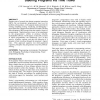Free Online Productivity Tools
i2Speak
i2Symbol
i2OCR
iTex2Img
iWeb2Print
iWeb2Shot
i2Type
iPdf2Split
iPdf2Merge
i2Bopomofo
i2Arabic
i2Style
i2Image
i2PDF
iLatex2Rtf
Sci2ools
92
Voted
VL
1996
IEEE
1996
IEEE
Steering programs via time travel
Despite years of research into human computer interaction (HCI), the environments programmers must use for problem-solving today--with separate modes and tools for writing, compiling, testing, visualizing, and debugging-derive their basic structure from historical accident, and take little advantage of HCI research into the cognitive issues of programming. Neglecting these issues is an impediment to the programmers' ability to produce reliable, maintainable software. In this paper, we describe a system in which programmers can modelessly steer as they specify, visualize, explore, and alter the behavior of a program while traveling through the program's logical time. This approach supports two often-neglected cognitive principles that programmers need for problemsolving.
Environments Programmers | Often-neglected Cognitive Principles | Program's Logical Time | Visual Languages | VL 1996 |
Related Content
| Added | 07 Aug 2010 |
| Updated | 07 Aug 2010 |
| Type | Conference |
| Year | 1996 |
| Where | VL |
| Authors | John W. Atwood Jr., Margaret M. Burnett, Rebecca A. Walpole, E. M. Wilcox, Sherry Yang |
Comments (0)

